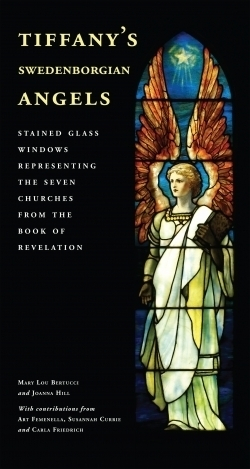Tiffany's Swedenborgian Angels
Stained Glass Windows Representing the Seven Churches from the Book of Revelation
“Love, no matter how pure and powerful, always needs the balance of wisdom for full and glorious expression,” write the authors of Tiffany’s Swedenborgian Angels in regard to the art glass window dedicated to the Angel of Pergamos.
Bertucci, former senior editor at the Swedenborg Foundation, and Hill, executive editor at the same institution, discuss the creation of seven stained glass windows. Each measures two and a half by eight feet and depicts an angel that “has a lesson to convey to those who understand the symbolism of the text and imagery.” For starters, they tell us, the seven stars in Revelation 1:20 represent the angels of the seven churches of Asia Minor.
During the last thirty years of his life, scientist, theologian, and seer Emanuel Swedenborg (1688-1772) experienced “waking visions” of the spiritual world, including conversations with angels and spirits. These experiences revealed to him a more spiritual meaning of the Bible.
In 1902, a Swedenborgian church in Cincinnati, Ohio, commissioned renowned glassmaker Louis Comfort Tiffany to make its windows. Tiffany’s unique craftsmanship is discussed, incuding the technique of using gem-like wedges of glass and rolling them to produce the effect of flowing fabric. The authors also tell of the resurrection of the windows in 2001 after decades of being crated in darkness.
Each chapter is dedicated to a different angel and includes Biblical passages, ecclesiastical meaning, spiritual sense through the theologian’s eyes, and angelic wisdom. “He that over cometh will I give power over the nations—and I will give him the morning star,” reads the epigraph to The Angel of Thyatira chapter. Beginning with a description of the stained glass window—an angel figure framed by red wings and holding a glowing golden star representing truth and good—the authors then discuss John’s epistle: those who maintain faith and charity are promised rewards. The difficulty, they go on to relate, is that The Church of Thyatira “has tolerated ‘that woman Jezebel’,” who represents faith separated from charity, which Swedenborg claims is a spiritual state of evil. Angelic wisdom concludes that such evil influences will result in those “without the necessary strength and clarity to withstand temptation.”
Sidebars to the main narrative include excerpts from Swedenborg’s books, painting references such as Pre-Raphaelite John Byam Shaw’s Jezebel, from 1896, and details of window restoration.
Art and spirituality reside together comfortably, and beautifully, in this book.
Reviewed by
Alex Moore
Disclosure: This article is not an endorsement, but a review. The publisher of this book provided free copies of the book and paid a small fee to have their book reviewed by a professional reviewer. Foreword Reviews and Clarion Reviews make no guarantee that the publisher will receive a positive review. Foreword Magazine, Inc. is disclosing this in accordance with the Federal Trade Commission’s 16 CFR, Part 255.

